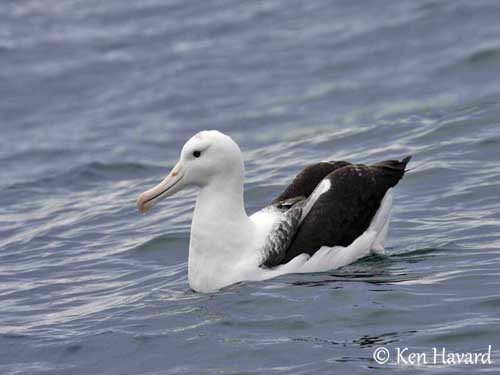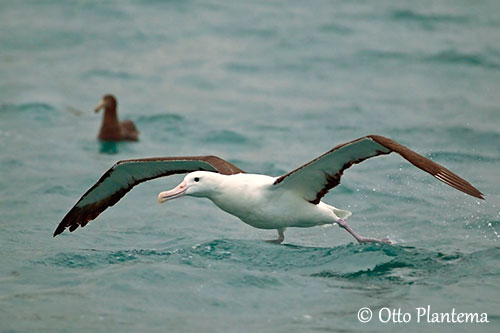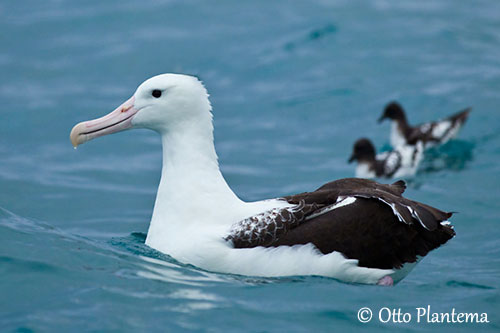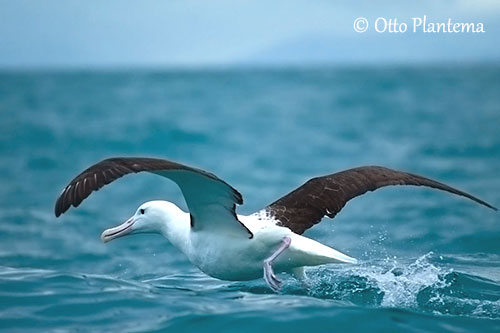
Fr: Albatros royal du Nord, Albatros de Sanford
Ang: Northern Royal Albatross
Maori: Toroa
All: Nördlicher Königsalbatros
Esp: Albatros Real del Norte
Nd: Noordelijke Koningsalbatros
Sd: Nordlig Kungsalbatross
Photographers:
Ken Havard
My Bird Gallery & Flickr gallery 1 & Flickr gallery 2
Otto Plantema
Trips around the world
Text by Nicole Bouglouan
Sources:
HANDBOOK OF THE BIRDS OF THE WORLD vol 1 by Josep del Hoyo-Andrew Elliot-Jordi Sargatal - Lynx Edicions - ISBN: 8487334105
KNOW YOUR NEW ZEALAND BIRDS by Lynnette Moon - New Holland Publishers – ISBN: 1869660897
BirdLife International (BirdLife International)
New Zealand bird status between 2008 and 2012
New Zealand birds and birding (Narena Olliver)
Wikipedia, the free encyclopaedia
Page family Diomedeidae
Summary cards
Northern Royal Albatross
Diomedea sanfordi
Procellariiformes Order – Diomedeidae Family
INTRODUCTION:
The Northern Royal Albatross was formerly a subspecies of the Royal Albatross (D. epomophora), but since 1998, it is a full species.
The scientific name “sanfordi” pays tribute to Leonard Cutler Sanford (1868-1950), ornithologist and trustee of the American Museum of Natural History.
The local Maori’s name is “Toroa”.
DESCRIPTION OF THE BIRD:
Biometrics:
Length: 115 cm
Wingspan: 270-305 cm
Weight: 6200-8200 g
The adult has white body plumage including the upperparts. However, the upperwing is black, whereas the underwing is white, except the black leading edge from the carpal joint to the wingtip. The tail is white, and can be sometimes black-tipped.
The head is white, although some females may have black-speckled crown.
The hooked bill is pale pink. The upper mandible shows a black cutting edge. The eyes are dark brown. Legs and webbed feet are pale pink to flesh.
During the nesting period, bill and tarsi are darker pink.

The male is slightly larger than female.
The juvenile is mostly white, with some black speckling on lower back and rump. The upperwing is blackish-brown with white markings on wing-coverts. The tail is white or sometimes dark-tipped. The crown may show dark speckles too.
RANGE:
The Northern Royal Albatross breeds in New Zealand, on South Island, in Otago Peninsula, and in the Chatham Islands (Forty-fours, Big and Little Sister Islands).
Outside the breeding season, most population can be found off both coasts of Southern South America, especially over the continental shelf and slope off Chile, and the Patagonian shelf off Argentina.
HABITAT:
The Northern Royal Albatross breeds on windy slopes with tussock grass for better shelter. But it also nests in more open sites, in order to land and take-off easily.
Outside breeding, it spends most time at sea.
CALLS AND SONGS: SOUNDS BY XENO-CANTO
The Northern Royal Albatross is usually silent at sea, but when feeding around fishing boats, it produces croaking and gurgling sounds.
The courtship displays are accompanied by throaty cries, groans, grunts and moans. The typical rattling sound is produced by clappering the bill quickly and several times, and is used during displays.
BEHAVIOUR IN THE WILD:
The Northern Royal Albatross feeds primarily on squid, usually caught at night when they reach the surface of the water. It catches fish close to the surface and also takes crustaceans, Salpidae and other cephalopods.
The bird alights on the water for feeding. It performs clumsy splashes while catching preys. Head and neck can be dipped to one metre underwater.
The Northern Royal Albatross often feeds alone, but they can gather at abundant food sources. It is a surface feeder. It scavenges too, taking dead or dying prey in the water. Discards and offal left by fishing boats are quickly scavenged.
Usually, the male arrives first at the colony. When male and female meet, they perform greeting displays with wing-clapping, accompanied by groans, while they hold their heads upwards.
The Northern Royal Albatross is monogamous and mates have long-term pair-bonds. Both adults share the nesting duties. They breed in colonies on remote islands, although the colony established at Taiaroa Head on Otago Peninsula (New Zealand) is the only mainland albatross colony in the world.
This species returns to sea after breeding and disperses over the Southern Ocean. Most of them winter on both coasts of S South America. Small numbers may winter off South Africa and Tasmania.
The Northern Royal Albatross is able to sustain a dynamic soaring flight, thanks to its long, narrow wings. It appears clumsy on land while walking from the nest to reach an open site to take-off into the wind.

REPRODUCTION OF THIS SPECIES:
The Northern Royal Albatross returns to the same nesting-site every year, usually in October or November. They breed every two years because the cycle is long. They can breed at 9-10 years old.
The nest is on the ground. It is made with grasses and mud, forming a shallow depression.
The female lays a single white egg. Both adults share the long incubation period during 11 weeks (77-79 days). They take turns of 2 days to 3 weeks, but usually of 8 days. The chick needs 3-6 days to emerge from the shell, after piercing it with the bill’s nail.
Both parents continue to take turns for guarding and feeding the chick during the first 5-6 weeks. The chick fledges about 8 months after hatching.

After breeding, the adults spend the following year at sea before to return to the colony for a new cycle.
If they fail to breed, they may renest in consecutive years until they are successful.
The young fledged albatross spends several years away from New Zealand, mainly in South American waters. They start to look for a mate at 3-8 years old.
PROTECTION / THREATS / STATUS:
The Northern Royal Albatross is often killed by longline fishing every year, in spite of protection measures. Harvesting of eggs, chicks and adults by local residents still occur on Chatham Islands. Storms and climatic changes also affect albatrosses. Introduced mammals are controlled and conservation measures are on their way.
However, the Northern Royal Albatross has very restricted range and is currently listed as Endangered. The population is estimated at 17,000 mature individuals. The population of Chatham Islands is about 99% of the total, and estimated at 6,500/7,000 pairs, with 5,200/5,800 breeding pairs each year (2003). Only 25 pairs breed every year at Taiaroa head.
But the numbers of breeding pairs appear relatively stable.
